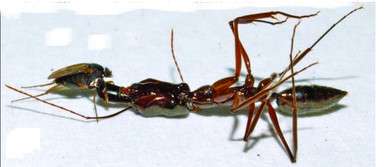Of flies and ants: New ant decapitation behavior of Dohrniphora flies

While watching tiny flies in tropical forests in Brazil, Giar-Ann Kung puzzledly remarked to Brian Brown "they are cutting the ant heads off!" This unexpected find led to the discovery of a grisly new type of behavior reported this month in Biodiversity Data Journal.
In the world of small insects, there is an astonishing variety of bizarre behaviors, but one of the most extreme is that of the ant decapitating flies of the family Phoridae. These tiny (1 to 3 mm long) flies inject their eggs into the bodies of ants, where after hatching the resulting larvae feed inside the host ant's head, eventually causing it to fall off. Such ant decapitating flies have been known for over 100 years, but recently scientists from the Natural History Museum of Los Angeles County have discovered a second, completely different type of ant decapitation in the Phoridae.
This new discovery involves a group of flies in a genus called Dohrniphora, best known as scavengers, because of one widespread, human associated species that is common in cities around the world. Another group of species native to South and Central America, however, do something different. Adult female flies are attracted to injured trap-jaw ants, from which they industriously sever the gut, nerve cord, and other connections of the head to the rest of the body. After working on it for a few minutes with their blade tipped mouthparts, the flies use their front legs to grab onto the ant head and tug until it pops off. The fly then drags the ant head off across the forest floor to a secluded spot where it either feeds on the head contents or lays an egg nearby.
The researchers were stunned the first time they saw this intricate headhunting behavior. Lead author, Dr. Brian V. Brown, says they were watching for another type of fly when these Dohrniphora turned up. At first, they were uninterested in these "scavengers", but after Kung's remark they watched, amazed, as the flies performed an intricate decapitation behavior, and then set off across the forest floor dragging their headhunting trophies.
In their paper, Brown, Kung, and co-author Wendy Porras document this ant - fly interaction with both photos and videos. Phorid flies are among the most biologically diverse families of insects, but the lifestyles of most are completely unknown. Nevertheless, as Brown quips, "you would think one type of ant decapitation would be enough for the family!"
More information: Brown B, Kung G, Porras W (2015) A new type of ant-decapitation in the Phoridae (Insecta: Diptera). Biodiversity Data Journal 3: e4299.DOI: 10.3897/BDJ.3.e4299
Provided by Pensoft Publishers



















